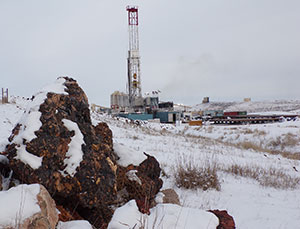Wyoming CarbonSAFE Project Team Drills Second Exploratory Well at Dry Fork Station
Published January 05, 2022

Led by the University of Wyoming School of Energy Resources (SER) and in collaboration with Basin Electric Power Cooperative, a team of researchers and partners on the Wyoming CarbonSAFE Project recently began drilling a second deep test well for site characterization.
Spudding of the test well near Basin Electric’s Dry Fork Station near Gillette began Dec. 23 and, despite the frigid temperatures and blustery wind, the well is nearing completion.
“This second well will lead to valuable information to fully characterize a second carbon storage site in Wyoming -- taking another step toward building a carbon capture, utilization and storage (CCUS) industry in the state,” says SER Executive Director Holly Krutka. “I am proud of the team in SER’s Center for Economic Geology Research and our project partners for their dedication in the adverse weather and over the holidays to advance this project.”
The U.S. Department of Energy-funded Carbon Storage Assurance Facility Enterprise (CarbonSAFE) initiative is to determine the suitability of the underground geological formations for commercial-scale carbon dioxide storage.
Phase 2 of the project investigated the storage complex feasibility with the drilling of a test well at the site and a 3D geophysical survey. The well was completed at a total depth of 9,873 feet, and 625 feet of core samples from nine different geological formations were collected for analysis, which has now been concluded.
“Results to date have shown that the geology located below the Dry Fork Station is suitable for commercial-scale geologic storage,” says Scott Quillinan, SER’s senior director of research.
Quillinan, who serves as a co-principal investigator on the grant with SER’s Fred McLaughlin and Kipp Coddington, notes that the efforts of the comprehensive team and project partners have played an integral part of the project’s success thus far.
“There has been a tremendous amount of work that has brought us to this point,” Quillinan says. “There are a lot of pieces that had to fall into place that have been built off the complex analysis of data by SER scientists and our project team. As we continue to advance the project, we are grateful for the expertise and support found here in Wyoming.”
The current project activities of Phase 3 are focused on finalizing the site characterization, well permitting and carbon dioxide capture assessment.
Adjacent to a first well that was completed in 2019, the new well allows researchers to gain valuable data and fully characterize the geologic layers of the subsurface site, including the target storage reservoirs and the cap rock seals.
According to McLaughlin, the interim director of SER’s Center for Economic Geology Research (CEGR), the second well will allow the team to design a testing program to measure the response of injection -- using water -- within the formations. Additionally, the team will address some of the research questions that previous field activities presented.
“We are so fortunate to be able to drill a second well at the study site,” McLaughlin says. “For the long term, we propose that this is the best way to optimize the injection of carbon dioxide in the three deep geologic formations that our technical team has characterized at the site. All of this will help us address remaining challenges for future commercial activities.”
To provide a full analysis of the site, other major ongoing activities include wide-scale baseline monitoring of soil gas, seismic activity and water samples. Charles Nye, a CEGR associate research scientist, has led the efforts.
“The detailed baseline analysis will allow us to differentiate between natural and anthropogenic CO2, monitor the migration of the CO2 plume and pressure front, and verify containment effectiveness,” Nye says.
A unique attribute of both wells is that they have been drilled and will be completed to meet Class 6 well construction standards and will likely become Wyoming’s first Class 6 CO2 injection wells for geologic storage.
Wyoming’s Department of Environmental Quality recently completed the permitting guidelines for Class 6 wells in the state, including both drilling a well and operating one. Additionally, this project will provide an open-book analysis of the Class 6 permitting process for all Wyoming stakeholders. The technical and regulatory team will publish the findings and results of drafting the Class 6 permits.
“These wells are the first two wells in Wyoming that will be completed to the rigorous standards of carbon storage wells, which necessitate the use of noncorrosive construction materials and an expanded subsurface testing program designed to meet permitting requirements,” McLaughlin says. “When the wells are constructed, the team will work to complete Class 6 applications in an effort to make the field site the first fully permitted and constructed carbon storage site in Wyoming.”
As drilling activities begin to wrap up, SER provided the opportunity for Wyoming stakeholders and media outlets to attend an exclusive open house today (Wednesday, Jan. 5). Experts working on the project provided updates, and attendees had the opportunity to tour the drill site.
“We are grateful for all of the support we have received to drive this innovative project -- from the Department of Energy, to the state of Wyoming and our project partners,” Krutka says. “Together, we are demonstrating that Wyoming has safe, secure CO2 storage options, and we appreciate the chance to engage with the public to discuss the opportunities for Wyoming and beyond afforded by the deployment of this exciting technology.”
For more information about the Wyoming CarbonSAFE Project, visit SER’s CarbonSAFE website at www.uwyo.edu/cegr/research-projects/wyoming-carbonsafe.html.

